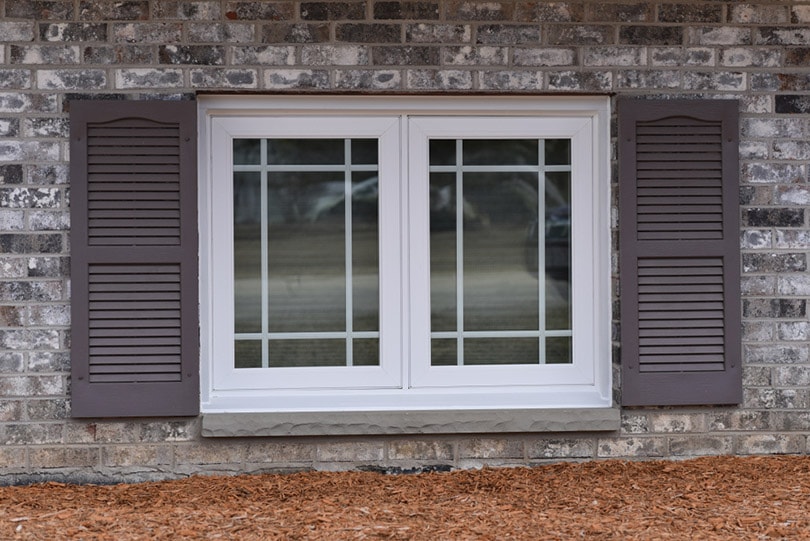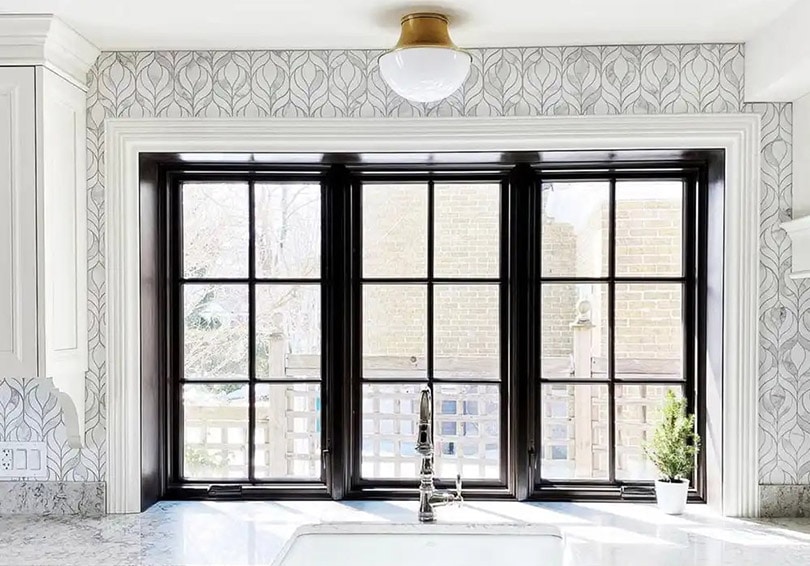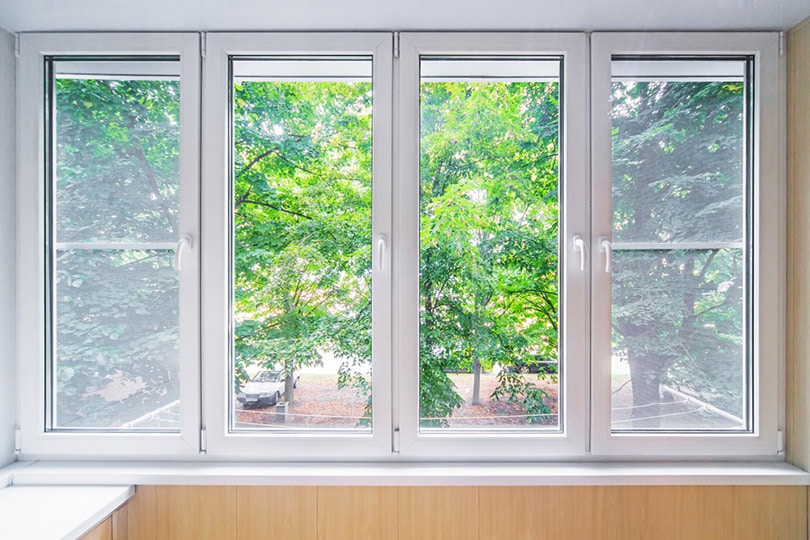Parts of a Window: Piece by Piece Identification Guide
-

- Last updated:

If you are shopping for new windows or are looking to get a single window fixed, repaired, or replaced, you are likely going to be bombarded with an avalanche of terms you might not be familiar with. Did it have a sash, or was it fixed? How many sashes did it have? Do you need a new mullion or casing with your window? Are the jambs okay?
If you are not prepared, these questions are going to be overwhelming. Windows can be very complicated and come with over a dozen different parts, pieces, and components. Choosing a new window or trying to navigate a window repair job is going to require a passing familiarity with the most basic parts of a window.
Here is a piece-by-piece identification guide for all of the parts of a window.
Parts of the Frame or Box
The frame, or box, is the part of the window that encompasses multiple parts that enclose the inner part of the window. The window box is a framework that supports every other part of the window. The window frame contains the head, sill, jambs, and apron of the window.
1. Head
The head is the part of the window frame that runs along the top of the window. This horizontal piece connects the jambs at the top of the frame.

2. Windowsill
The sill or windowsill is the horizontal part of the window frame that runs along the bottom of the window. The windowsill is the bottom twin of the head, which runs along the top of the frame. All windows feature a sill and a head.

3. Jamb
Jambs are the two vertical elements of a window frame. The jambs run down from the head and connect the head to the sill. In a double or triple window, there will be multiple jambs that are connected to form a larger window. All windows have a minimum of two jambs.

4. Apron
The apron is a decorative piece of the window. The apron is installed below the sill and hangs down to add volume to the window. Aprons can be installed at the discretion of the contractor or homeowner. They have no bearing on the strength or integrity of the window itself.
5. Weep Holes
Weep holes are small holes that appear at the bottom of aluminum windows. The weep holes allow condensation, rain, and other moisture to slowly escape to the outside of the window. Weep holes prevent windows from fogging up or holding moisture that could be damaging over time. Any window can collect moisture, but condensation appears most frequently on aluminum window frames due to the cold nature of metal as opposed to wood or vinyl.
6. Casing
Window casing covers the gap between the window and the wall or frame of the house. Not all windows have an interior casing, but all windows will feature some sort of exterior casing. Exterior window casing can be made from metal, vinyl, cement board, or wood. Window casing helps seal the window, adds an aesthetic benefit, and closes any gaps that could lead from the outside of your house inside.

7. Mullion
A mullion is a piece of a window that is used to fuse two windows together. Mullion is used to join two window jambs and create a double or even triple window. Many double windows are simply two single windows that are joined via a piece of mullion in the middle. Mullion makes the windows look coherent and increases the appearance and flow of the window unit.
Parts of the Sash
The sash is the inner part of the window that includes the moving parts and the glass. Window frames are designed to support and contain the window sash. The sash is the most important part of the window and the most complicated and fragile component.
1. Pane
The pane is the actual glass that goes into your window. A window can contain multiple panes of glass. Panes are the part of the window that most often breaks, especially if the window is struck.

2. Rail
Rails are the parts of a pane that hold the glass in place. Windows do not have raw, unprotected glass in them. Even the panes have an edge that holds them in place and protects you from the sharp edges of the glass panels. Rails are the equivalent of jambs, heads, and sills for the window frame. The rails make up the horizontal and vertical parts of the windowpane. They are like tiny frames for the pane itself.

3. Lock
The lock is the mechanism that locks the window and prevents it from opening. Window locks are an important security feature that most homeowners demand in their residential windows. Without a lock, anyone could open a sliding window. Fixed windows have no need for locks. Window locks are only found on movable or operable windows.

4. Lift
The lift or lifter is the part of a window that helps the user open it. Lifts can be small handles or simple indentations. Anything that you can use to grab onto the window and slide it upward is considered a lift. Some windows do not have lifts. Some single-hung windows simply have you grab the lip of the bottom sash to pull upwards. That would do the job of a lift, but lifts are specific parts added to a window to make it easier to open.

5. Weatherstripping
Weatherstripping is a type of insulation that seals the window. Weatherstripping is put into the gaps around the window that prevent any air or moisture from being exchanged between the inside and the outside. Weatherstripping is often found between the sash and the frame or anywhere the window moves to give it an extra layer of protection.

6. Grilles
Grilles are the decorative pieces put on top of the pane or inside of the pane of the window. Grilles add patterns that give a window a more unique look. A window that is divided up by lines is a grilled window. Grilles can be applied to the outside of the pane or put in between two panes of glass. Grilles can be used to create a variety of different patterns that homeowners can choose from to give their windows some extra character or design elements.

7. Balance
A balance, or balance rod, is a component of the window found in double-hung and single-hung windows. The balance is often located in the sash or the track around the sash, which helps to keep the window balanced during use. They can be spring-loaded and help windows move more smoothly during operation. The balance is not usually visible, but it can break or become jammed over time.
8. Fixed Pane
A fixed pane is simply a pane of glass that does not move. Single-hung windows include one fixed pane and one sash. Picture windows contain one continuous fixed pane where nothing moves. Double-hung windows include two sashes and no fixed panes.

9. Sash
As opposed to a fixed pane, a sash is a movable pane. If you have a window that opens by moving up or down, the piece that moves, and its corresponding glass, is the sash. Sashes include the small pieces and the modified rails needed for the pane to move.

Window Extras
There are a lot of different extras and accessories that can be sold as part of a window or with a window. These extras are often added on during the manufacturing process and require a special order to obtain. These extras are not common in basic windows.
1. Low-e
Low-e glass stands for low-emissivity glass. Low-e glass is treated with special clear coatings that are designed to block ultraviolet (UV) and infrared light. Since the coatings are clear and invisible, they do not hamper the flow of natural light through the glass. By blocking UV and infrared rays, low-e glass helps keep interiors temperature regulated. Low-e glass keeps homes cooler in the summer and warmer in the winter without adding too much cost or hampering visibility. Low-e glass has become very popular in recent years as homeowners strive to be more energy efficient than ever before.

2. Argon Glass
Argon glass is a special type of insulated glass that can be purchased in cold environments. Argon glass uses a spaced windowpane that is then filled with argon. Argon is an invisible gas that acts as a medium that helps keep heat inside the house during the winter. Windows are one of the largest areas of heat loss during the winter (and heat gain during the summer.) In the summer, most people use blinds or curtains to help keep the sun out of their houses. In the winter, keeping the heat in is a lot harder. Argon glass uses argon gas to help keep the heat from escaping through the windows.
3. Screens
Screens are sold with windows and are a complementary part of a window system, but they are technically not a part of the window properly. Screens are attached to the outside of a window to block bugs, animals, dust, dirt, and water from entering the house if the window is open. Without a screen, an open window is a gaping hole from the inside to the outside. Some windows have screens built in, but a vast majority of windows still use separate screens as accessories rather than a component.
4. Treatments
Windows can also come with a variety of treatments. Window treatments can include waterproof coatings that help keep the windows dry, or they can include pre-installed miniblinds that exist inside the windowpane. Window treatments help protect the windows and block things like sunlight and rain.
Window treatments can also include tinting, curtains, blinds, shades, or shutters. In many cases, window treatments are applied after the fact but not always. Waterproofing or tinting can be installed by the people putting in the windows. Miniblinds are installed by the manufacturer, and the windows are shipped with the blinds already inside the panes of glass.
5. Sliders
Some windows are sliding windows. Sliding windows open horizontally rather than vertically and are like small sliding glass doors. In fact, sliding glass doors are also usually sold by window manufacturers. Sliding windows have additional parts, such as tracks.

There Are Dozens of Window Configurations
These are the most common parts of a window you will encounter in nearly every window in the world. However, there are dozens (if not hundreds) of different configurations, combinations, and styles of windows. Windows can be made from wood, metal, or vinyl. They can be clad, meaning that there is a base frame coated or covered by a different material.
There are fixed windows, awning windows, sliders, cranks, single-hung, double-hung, double single-hung, triple double-hung windows, and more. All of these different types of windows can be combined with different glass, different sizes, different extras, and different accessories.
All of that is to say that this list is not exhaustive. There are going to be specialty parts, such as the crank for an old casement window, that won’t be found on most common windows. Awning windows have hinges on them. Wood windows have different treatment options than vinyl windows. You might run into some odd things if you get specialty windows, antique windows, or custom windows.
Some manufacturers and installers also break down each individual part into sub-parts. For example, some people call horizontal grills muntins. Some manufacturers make a distinction between top rail, bottom rail, and side rails on a pane of glass. Despite their ubiquitous and unassuming nature, windows are actually extremely variable and very complicated.
In Conclusion
The vast majority of common windows will contain these sixteen basic parts and pieces. Some windows will have more parts, and some windows will have fewer parts. A small picture window won’t have as many parts as a double casement window on an old house. But every window will feature some or most of these parts on a regular basis. Next time you glance at a window, you should be able to see it as a complicated result of over a dozen different pieces coming together to do one singular job.
Featured Image Credit: Africa Studio, Shutterstock
Contents

